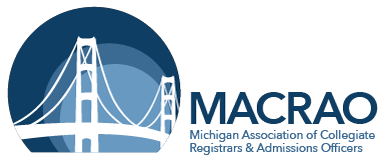A Brief History of MACRAOIn 1910, twenty-four college and university registrars and business officers, feeling the need to discuss their common responsibilities, met in Detroit, Michigan. Before adjournment, of this conference, the participants organized the American Association of Collegiate Registrars. From this small initial meeting, AACRAO has grown to a membership of more than 2,000 institutions with some 7,500 active members in the areas of admission, registration and records, international education, and institutional research, as well as affiliate member organizations. These members represent many types of institutions of higher education in the United States, Mexico, Canada and other countries. In 1949, when many institutions began to establish separate offices of admissions and records, AACRAO adopted its present title: the American Association of Collegiate Registrars and Admissions Officers (AACRAO). Our Michigan Association of College Registrars (MACR) hosted its first meeting in 1921 on the campus of Michigan State Normal College (now Eastern Michigan University) in Ypsilanti. Four schools were represented: in addition to MSNC, registrars from Michigan Agricultural College (now Michigan State University), Kalamazoo College, and Detroit Teachers College (later merged with several other schools to become Wayne State University) attended the first meeting. Early meeting topics would seem familiar to today's MACRAO members: orientation, testing, uniform application forms, academic dismissal standards, graduation requirements. In 1949, institutional membership dues were $1.00 per school; the organization spent a total of $15.90 and had a bank balance at the end of the year of $112.84. Like the national organization, we recognized the changes in our profession and adopted the name Michigan Association of Collegiate Registrars and Admissions Officers (MACRAO) in 1949. In the fifties, a major change in admissions standards happened when standardized testing began to be widely used along with high school grade point averages. Recruitment of freshmen students began to grow, and the college fair circuit was organized, largely by MACRAO in Michigan. Community colleges also began to boom at this time, providing another place for potential post-secondary students to attend. In the 1960s, the baby boom generation of post-World War II children began to enter college, creating challenges as enrollment numbers shot up quickly. As more students looked to transfer credits between junior and senior colleges, MACRAO's first College Articulation Workshop was held in June, 1962, at Alpena Community College. In November, 1970, the MACRAO Articulation Agreement was "born" at the association's annual meeting at St. Clair County Community College, going into effect during the 1972-73 academic year. A month later, an ad hoc committee began studying the possibility of a state-wide common admissions system, and MACRAO's annual budget had increased to nearly $3,000 per year. In 1979, MACRAO worked on the "ESCALATE" project, that hoped to create a state-wide computerized system to make transfer equivalencies easier to track. In the 1990s, MACRAO's Registrars Practices Committee helped to set institutional standards related to the Family Educational Rights and Privacy Act (FERPA). As the World Wide Web became commonplace in the late 1990s and early 2000s, MACRAO was pivotal in the creation of the original Michigan Transfer Network website, which made it easier for students, counselors, and advisors to discover how courses would transfer from one institution to another. MACRAO was again involved as the next generation of that resource, MITransfer.org, was launched in 2019. MACRAO continues to be a leader in higher education in the state of Michigan and nationally, providing expertise and advice to other professional organizations, institutional leadership, legislators and legislative staff, and tens of thousands of college and university students every year. Past MACRAO Leadership
Honorary MembersMACRAO has had many special members who went above and beyond to contribute to the association's success, and those people have been recognized with Honorary Membership. The first Honorary Memberships were awarded in 1955, and periodically since then. |
